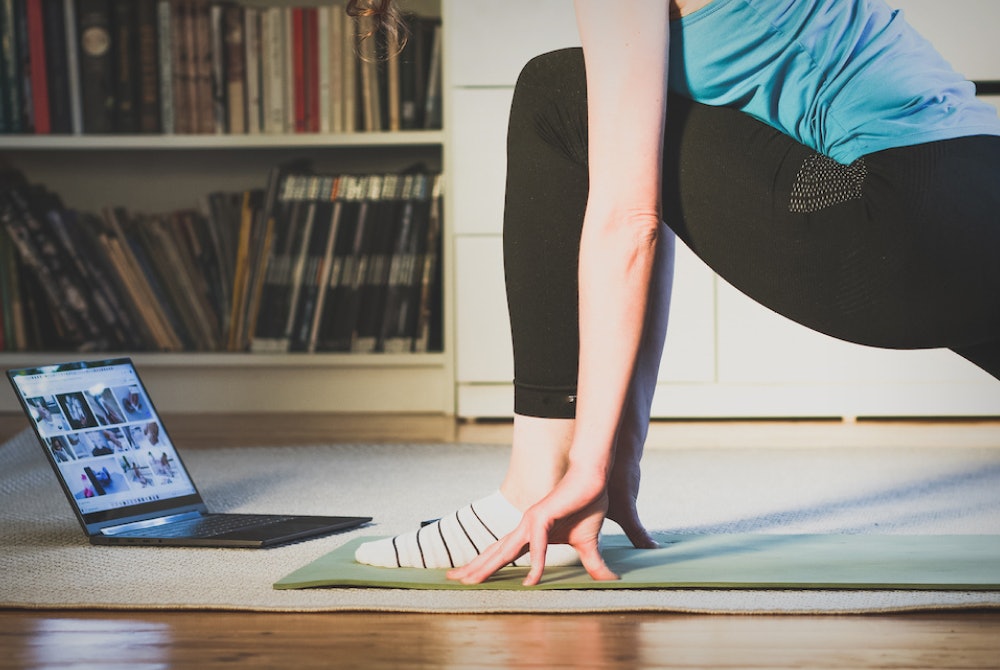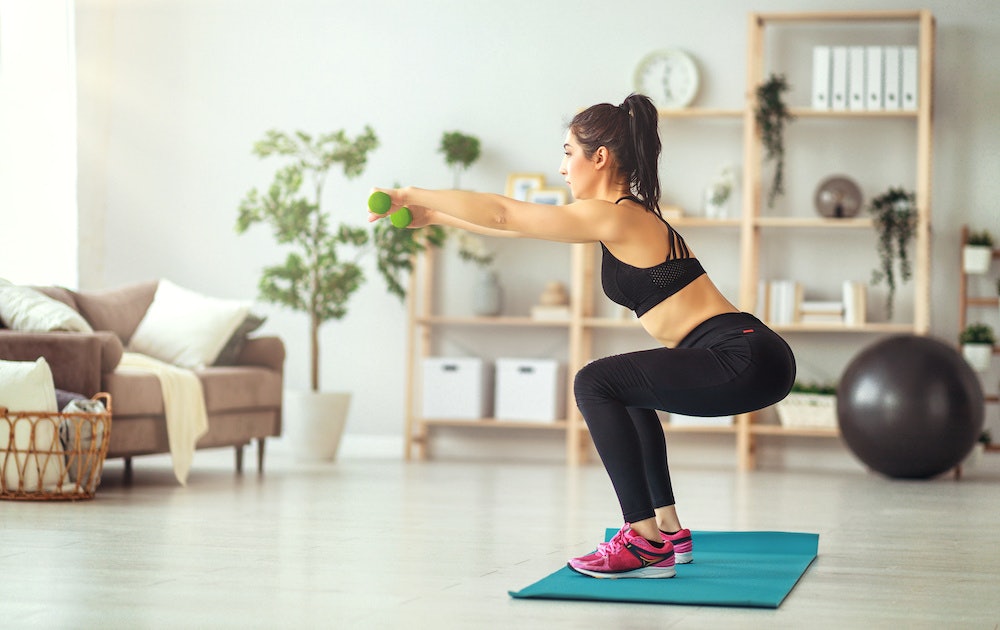- The Benefits of Exercise on The Immune System
- Is Exercising With COVID Safe?
- Does Exercise Reduce the Effects Of COVID-19?
- When Should You Avoid Working Out?
- Tips to Stay Active While in Isolation
- How to Restart Exercise Post COVID
In the ever-changing world of the COVID-19 pandemic, understanding what you should and shouldn’t do can sometimes feel like a confusing guessing game in which no one really knows the real answer. However, since coronaviruses have been around for centuries, we do have some clear answers on whether exercising with COVID is safe or not.
Whether you’re partially or fully vaccinated, received your booster shot, or have chosen not to receive the vaccine, read below to learn about how to stay physically active while sick.
The Benefits of Exercise on The Immune System
In general, regular moderate to vigorous exercise can be a great way to boost the immune system while also improving its immune responses to vaccination, especially when sick.
According to the American College of Sports Medicine (ASAM)
"Not only can exercise have a positive direct effect on the cells and molecules of the immune system, but it is also known to counter the negative effects of isolation and confinement stress on various aspects of immunity."
Many experts will use the “above the neck” rule as a way to advise people on whether they can continue working out. According to this theory, when experiencing symptoms above your neck only (e.g., sneezing, earache, runny nose), then you’re likely okay to engage in mild-intensity activities for a shorter period.
Therefore, when experiencing symptoms “below the neck” such as a hacking cough, body aches, chest pain, chest congestion, or an upset stomach, then you should refrain from exercising. This is also the case for those experiencing a fever; it’s the body’s way of telling you it needs rest to heal.
Is Exercising With COVID Safe?
Though experts agree that there are many benefits to working out when sick, it still begs the question, “Is it safe to work out while you have COVID-19?”
Since each person is unique, and COVID can affect people differently, there’s not one hard and fast answer. From a public safety standpoint due to its highly contagious nature, the CDC and healthcare professionals recommend that (as of March 2022):
- Individuals should remain in isolation for at least 5 days from the date of a positive test (if no symptoms are present).
- Individuals should isolate for at least 5 days from the date symptoms began, which would be considered day 0.
Following those five days, patients should wear a mask for 5 additional days to avoid spreading the disease to others. Other than that, however, there is not enough research on the effects of working out in individuals with COVID.
How Long Should You Wait Before Exercising Again
Researchers and experts err on the side of caution when it comes to exercising with COVID and suggest waiting approximately 2 weeks before doing any physical activity.
ACSM is a little less strict with their recommendations after testing positive. They suggests asymptomatic patients rest 7 days while low-risk patients should rest for at least 10 days after being diagnosed.
Regardless of whether you wait 7 days or 12, because of the many unknowns of COVID-19, it’s important to take a conservative approach regarding exercise until more is known about its effect on the disease.
If you’re unsure of when to start exercising again, or need to know how it may affect you personally, it’s a good idea to consult your healthcare provider first.
Does Exercise Reduce the Effects Of COVID-19?
Yes, exercise have been shown to minimize the effects of COVID, similar to how regular physical activity can help boost the immune system in both healthy and sicks adults.
In a large-scale study published this year, researchers looked at 48,000 adults in the U.S. who were diagnosed with COVID-19 to see if being sedentary vs. physically active had any effect on individuals’ symptoms.
The study found that, when compared to consistently active individuals, sedentary individuals (performing less than 10 mins per week of exercise) were:
- 26 times more likely to be hospitalized
- 73 times more likely to be admitted to the ICU
- 49 times more likely to succumb to the illness
Further, the odds for hospitalization, admission in the ICU, and death were higher for those who only performed around 11–49 minutes of moderate to strenuous activity per week.
Similar results were found in a study of individuals who performed at least 150 minutes per week of moderate-intensity or 75 minutes a week of vigorous-intensity physical activity.
Researchers from Brazil found that sufficient physical activity levels were associated with a 34.3% reduction in hospitalizations compared to sedentary individuals.
When Should You Avoid Working Out?
There are a few times when you definitely shouldn’t try resuming physical activity because it can cause further issues or exacerbate your current systems.
Productive or Frequent Cough
Though coughing can be normal when sick, more frequent episodes of coughing can be a symptom of a respiratory infection. It’s a sign that your body needs additional rest.
Further, having a persistent cough will make it harder to breathe normally once your heart rate is increased with exercise. The same goes for coughs that bring up phlegm or sputum, this is another sign of an infection that requires rest and treatment.
Fever
If you are experiencing a fever, it’s typically due to a bacterial or viral infection. Fevers tend to make your body weak, suppress your appetite, and can leave you dehydrated. Working out may increase the risk of dehydration and increases your risk of injury due to decreased muscle strength and endurance.
Digestive Issues
Physical activity is not advised if you’re experiencing digestive issues such as a stomach bug. Symptoms usually include stomach cramping, decreased appetite, diarrhea, nausea, and vomiting. You risk further dehydration if you resume exercising or spreading your illness to others since many stomach issues are highly contagious.
Tips to Stay Active While in Isolation
If you find that you need to self-isolate after testing positive but are only feeling symptoms above the neck, there are some ways you can incorporate physical fitness while at home. This includes:
Create a Workout Space
Having a space dedicated to working out can help you mentally prepare yourself to begin exercising with COVID at home while in isolation. Set aside a space in your home or garage that you’ll setup as a home gym.
Even if you only have a small corner to work with, having it already designated as your workout area will make it easier to get motivated. Pro Tip: Create this space near natural light and create a new “isolation” workout mix to make it feel more engaging.
Purchase Home Gym Essentials
You don’t need big equipment or lots of weights to get a solid workout at home. But ensuring you’re stocked up now on the essentials can make it easier to figure out a workout plan while in isolation.
Some basics to include in your shopping cart include:
Communicate With Your Trainer
If you already have a trainer, connect with them and let them know your condition and ask them for a home workout routine that you can follow. Alternatively, there are plenty of free resources online for at-home fitness classes that you can utilize while recovering.
Keep in mind that you’ll likely need to exercise at a lesser intensity than you’re used to so that you don’t overtrain.
Schedule Your Workouts
Just like you do with your weekly exercise routines, set aside a time each day that you’ll commit to working out. Make sure you don’t have to worry about any distractions during this time such as streaming your favorite show or having your notifications on for your phone.
How to Restart Exercise Post COVID
Patience is key when resuming exercise post COVID-19 diagnosis. How quickly you should jump back into your regimen depends on your age, prior health and fitness level, and how severe your symptoms were while sick.
It is recommended that you slowly work your way back to your previous fitness routine by avoiding lifting weights and engaging in more low-intensity workouts such as:
- Yoga
- Swimming
- Cycling
- Walking
- Stretching
Keep in mind, you may need to also work your way up to longer workout times when you're recovering from COVID, so start small and do 15- to 20-minute exercises the first week, then progress to 30 mins., 45 mins. and so on.
When to Seek the Advice of a Physician
If you have underlying health conditions such as high blood pressure or diabetes, were hospitalized due to complications, or have lingering symptoms of long COVID, you should consult with your healthcare provider before becoming physically active again.
Lastly, listen to your body; stay hydrated, get plenty of sleep, and focus on eating healthy. When an exercise feels like too much, stop the activity completely or try a lower-intensity workout.



Comments